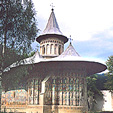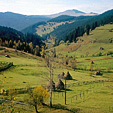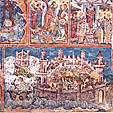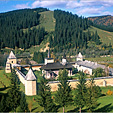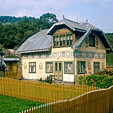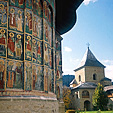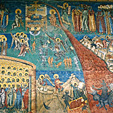HIGHLIGHTS SURROUNDINGS
The "Painted Monasteries":
Moldovita Suceava
Sucevita Rasca Monastery
Voronet Dragomarna Monastery
Humor Ciocanesti
Arbore Agapia Monastery
Marginea Pottery Varatec Monastery
Putna Monastery Neamt Monastery & Fortress
Solca Church Lake Bicaz & Mt.Ceahlau
Moldovita Forest Railway
Rarau Mountain
Much of the former Romanian province of Bucovina, previously part of the Austro-Hungarian Empire, was lost to the USSR (now the Ukraine) in 1945 together with its capital, Cernauti. The southern part which falls away to the east in a series of steep, wooded ridges, the "crests (obcinie) of Bucovina" comprises the present day county of Suceava.
The Bucovina has large natural reservations of fauna as well (stag, roebuck, bear, wild boar, capercaillie, lynx). The rich hunting fauna (wild boar. stag. pheasant, or partridge) is under the law protection on a surface area of 320.000 ha and fine water surfaces (for fishing) can be found in all valleys.
There are here good facilities for the summer and winter sports, for hunting and fishing, as well as for rest in large oasis of calm. The mountains of Suceava has natural varied and attractive places. A wonderful route is the one to the Calimani volcanic massif, or to the Giumaslau and Rarau massive, the last one being known for its karst relief. Some wonderful landscapes are offered by the narrow pathes of the Bistrita Aurie River, Upper Valley of Moldova and Suceava Rivers.
As well as to its wonderful landscapes, folk life, numberless cultural and historical monuments and make the Bucovina one of the important turistic area in Romania
Among the vestiges perfectly integrated into the nature, a special mention has to be done in connection with the painted monuments which are included by the UNESCO among the masterprices of the world art. Also the International Federation of Tourism Journalists and Writers (FIJET) awarded the POMME D'OR international Prize in 1975 to this zone known now all over the world.
The 'Painted' Monasteries of Bucovina are true masterpieces - their outer walls covered with byzantine frescoes, stories from the bible. They were founded in the 15th and 16th centuries and, together with the church of Arbore form an important part of UNESCO's patrimony.
The ruling princes still found the respite to erect true religious architectural gems despite being compelled to submit to Ottoman domination. Stephen the Great of Moldavia (1457-1504), was responsible for Putna (1466-1468), Patrauti (1487), Neamt Monastery (1497), and the painted church of Arbore. His descendant, Petru Rares, continued his work by setting the foundations for the famous 'Painted Monasteries' - Humor (1530), Moldovita (1532), Sucevita (1584) and Voronet (1547).
The principal painted monasteries are:
Voronet - the 'Sistine Chapel of the East', with remarkable frescoes of an intense shade known as 'Voronet Blue', including the fascinating 'Final Judgment' on the back wall.
Moldovita - of particular interest is a depiction of the Siege of Constantinople with the Christians winning!
Sucevita - the largest, and perhaps the most impressive nestled between the scenic, wooded hills. The church is covered by frescoes, including a well-preserved representation of Jacob's Ladder, and is surrounded by massive defensive walls.
Humor - smaller, than the other complexes, with prevailing hues of red-brown and a depiction of the Devil as the 'Scarlet Woman'!
There is also a painted church at Arbore with equally impressive frescoes. This part of Moldavia is also known for its other fortified monasteries, notably Putna (where Stephen the Great is buried), and Dragomârna near Suceava, with its unusually tall church. Further south are other significant monasteries including Agapia, Varatec and Neamt. Close to Sucevita is the village of Marginea, known for its curious smoked, black pottery, which is sold along the roadsides or at the studio where it is made. Moldovita is also home to a forestry railway which rarely sees any use nowadays - however, the two steam locomotives are maintained in the shed for tourist and enthusiast groups.




